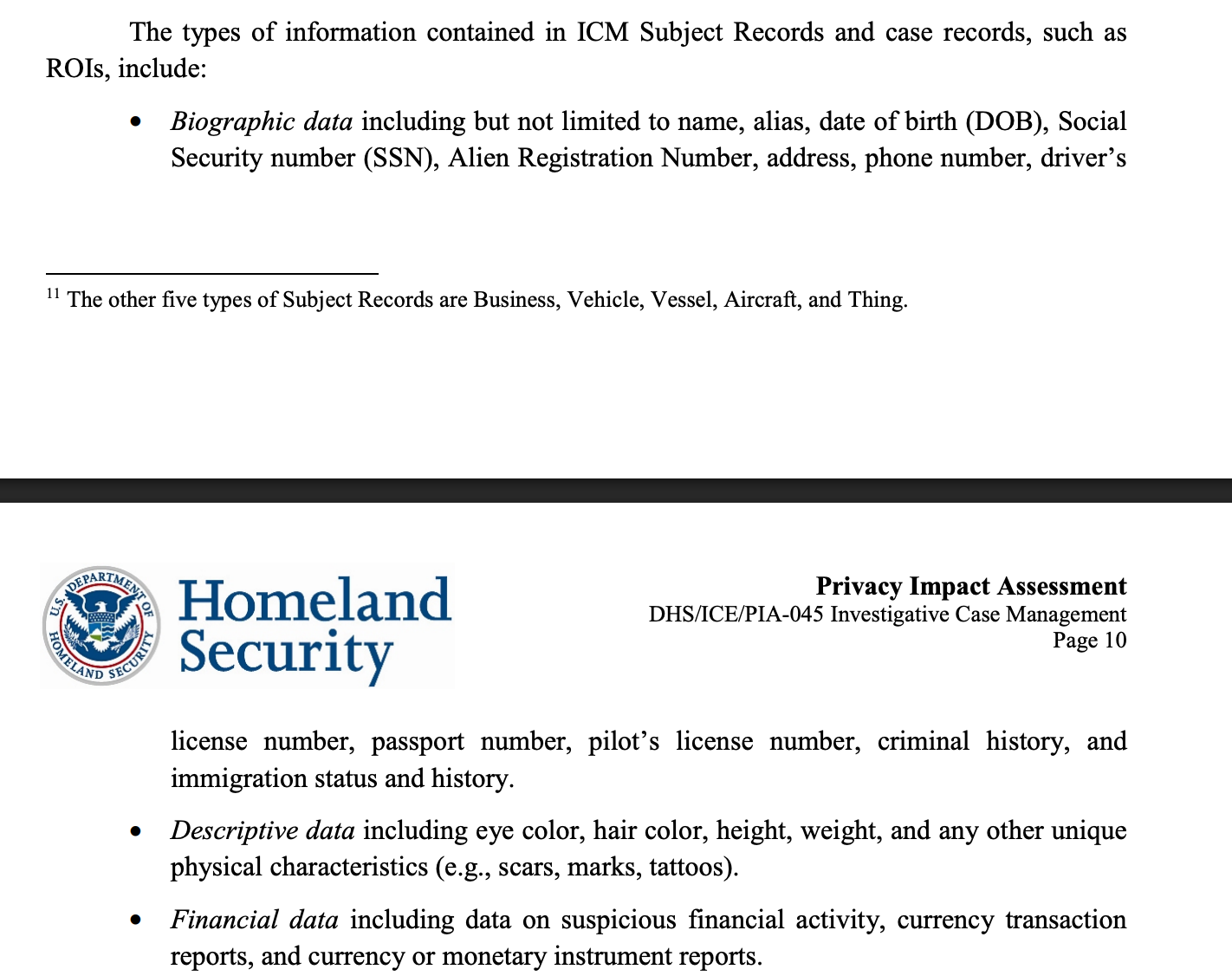
A powerful Immigration and Customs Enforcement (ICE) database, parts of which have been seen by 404 Media, allows the federal government to search for and filter people by hundreds of different, highly specific categories. Surveillance experts say the database is a tool that could possibly be helping ICE identify, detain, and deport people who are suspected of relatively minor infractions or who fit certain characteristics, but said the fact that we don’t necessarily know the exact mechanisms by which people are being identified and detained is a major problem.
The database, called “Investigative Case Management” (ICM), “serves as the core law enforcement case management tool for ICE Homeland Security Investigations (HSI),” according to a 2021 privacy impact assessment for the tool.
404 Media saw a recent version of the database, which allows filtering according to hundreds of different categories, which include things like resident status and entry status (“refugee,” “border crossing card,” “nonimmigrant alien refused admission,” “temporary protective status alien,” “nonimmigrant alien transiting without visa,” “undocumented alien,”); “unique physical characteristics (e.g. scars, marks, tattoos)”; “criminal affiliation”; location data; license plater reader data; country of origin; hair and eye color; race; social security number; birthplace; place of employment; driver’s license status; bankruptcy filings, and hundreds more. A source familiar with the database told 404 Media that it is made up of “tables upon tables” of data and that it can build reports that show, for example, people who are on a specific type of visa who came into the country at a specific port of entry, who came from a specific country, and who have a specific hair color (or any number of hundreds of data points).
ICM was created by Palantir, the powerful and controversial surveillance and data management company. In 2022, Palantir signed a $95.9 million, five-year contract to work on ICM.
ICE agents can set up a “Person Lookout Query” that sends email notifications if a person suddenly triggers the parameters of a search query. 404 Media has seen parts of the infrastructure of this database, which shows the characteristics that can be searched for, as well as several example reports that can be generated by it.
A 2016 privacy impact assessment filed by DHS about the database says that ICM connects to other DHS and federal databases, including SEVIS, which are records about all people who are admitted to the United States on a student visa; another search tool called FALCON; “real-time maps” associated with ICE’s location tracking tools; “limited location data from license plate reader cameras operated by ICE,” as well as information from “other federal agencies.” The Intercept previously reported those agencies include the DEA, the FBI, the ATF, and the CIA.

The privacy impact assessment says that different parts of ICE, including Homeland Security Investigations and Office of the Principal Legal Advisor (ICE’s legal team) use the database. Crucially, it says that ICE’s Enforcement and Removal Operations (ERO) division “uses ICM in a more limited way than HSI in support of its mission to enforce U.S. immigration laws by identifying, arresting, and removing aliens in a way that is consistent with current enforcement priorities.”
Learning the capabilities and use cases for a tool like ICM has become critical and urgent over the past several weeks, as ICE has detained, arrested, and deported college students, tourists, and Green Card holders who have either no apparent criminal records or have only minor, nonviolent infractions. It has detained and deported at least 238 people to a mega prison in El Salvador without due process; a 60 Minutes investigation found that an “overwhelming majority have no apparent criminal convictions or even criminal charges.” ICE has detained and deported people to the El Salvadorian prison because they have certain tattoos, and, in one case, deported a person which the Trump administration admits was a mistake and now refuses to bring back to the U.S.
College students on student visas have had their visas revoked over speeding tickets and other minor infractions, and students have also had their visas revoked for protesting against Israel’s war in Gaza. Tuesday, the Internal Revenue Service announced that it will begin sharing tax information with ICE for the purposes of immigration enforcement, a massive and concerning escalation in data sharing across government agencies, and the type of data sharing that can supercharge these types of databases.
Jeramie Scott, senior counsel and director of the Electronic Privacy Information Center’s Project on Surveillance Oversight, told 404 Media that “Given the current administration, there is the possibility they treat everyone in the database as the target of deportation and detainment. The current administration is not heavy on nuance or details, and likes to use a broad brush to paint their characteristics of people.” Scott pointed out that ICM’s privacy impact assessment says that, because it is pulling in so much data, there is the possibility that anyone in there, for any reason, could become the target of an investigation or could be flagged for additional screening or deportation.
“Because ICE may create Subject Records on individuals who are not targets of investigations, there is a risk that these individuals may be mischaracterized as, or misunderstood to be targets,” the 2016 privacy impact assessment reads. “Among other concerns, this may cause individuals to experience difficulties at ports of entry where CBP uses Subject Records in screening.” The privacy impact assessment also notes “There is a risk that information will not be accurate, complete, or timely.”
The database also impacts U.S. citizens, according to funding documents previously obtained by The Intercept. “U.S. Citizens are still subject to criminal prosecution and thus are a part of ICM,” one reads.
“There are two, kind of scary things that are coming together. One is this high tech surveillance, including databases that keep track of all sorts of things about people, and the other is a government that is motivated to deport immigrants even when they are not any kind of threat to us,” Adam Schwartz, privacy litigation director for the Electronic Frontier Foundation, told 404 Media. “It certainly sounds possible that some of the recent detentions and arrests we’ve seen of immigrants who are not any kind of threat to the country—perhaps ICE is using these sorts of databases that have all kinds of information about immigrants and others to identify people for detention.”
Three experts 404 Media spoke to, including Schwartz, say that it is critical that the American people understand the exact mechanisms and technologies that ICE is using to identify and detain people, and that knowing this information is vital for people who are detained and deported to know in order to fight their cases.
“For half a century or more, one of the first principles of data privacy has been if government collects data for one purpose, government should not use that data for another purpose without permission of the data subject,” Schwartz said. “One of the reasons this has been so central to data privacy is that it’s not just what the advocates want, but if you don’t follow this rule, really bad things happen. In 1942, the U.S. Census Bureau had information about the addresses of Japanese Americans, and they gave that info to the Department of Defense, who used it for the purposes of rounding up and detaining innocent Japanese Americans. If the government collects information for reason one, they shouldn’t be sharing it with others for reason two.”
Scott, of EPIC, said that it “absolutely matters” which tools are being used by ICE to identify and detain people. “There is the potential that people are getting picked up who are purely doing protected activities,” he said. “There’s the possibility that information is being shared in ways that are not properly being regulated, not properly being revealed, and there’s a lot of potential there for information that was collected for one purpose and is supposed to be cabined for one purpose being shared with ICE for detention or deportation reasons, and the American people need to know that. They need to know whether their government is upholding the constitutional values of this country.”
Elizabeth Laird, director of equity in civic technology for the Center for Democracy and Technology, said that when information is shared across the government, the potential of “false positives and false negatives” is high.
“You’re trying to match people and you incorrectly say that it’s the same person across systems because the name is slightly different or the birthday is transposed, and you may not have enough elements to be confident that it is the same person,” she said. “When you have lists of millions of people, it’s hard to imagine that you don’t have a significant population who are being false matched as warranting immigration enforcement action when it is in fact the wrong person, and we’re seeing those mistakes happen, where a person is wrongly deported to El Salvador, and the government is saying we can’t get them back.”
Laird said the fact that the IRS is now going to be sharing information with ICE is particularly bad, especially when for years the U.S. has assured immigrants that doing things like seeking healthcare, getting a driver’s license, or paying taxes would not be used for immigration enforcement purposes. “It creates disincentives for undocumented immigrants to interact with the government, and that includes on things like paying their taxes,” she said. “So we need to not only wrestle with is this even legal or ethical, we also need to think about, are these the kind of consequences we want to live with in this country?”
Separately, 404 Media has reported on various other ways ICE and the broader DHS collects data on people, including a surveillance contractor called Shadow Dragon that pulls information from social media, and another that scrutinizes social media posts to determine if they are “derogatory” to the U.S., and then use that information as part of immigration enforcement. ICE has also used location data harvested from smartphones to track the movements of people.
ICE did not respond to a request for comment or specific questions about how ICM is used from 404 Media.
Samantha Cole contributed reporting.




